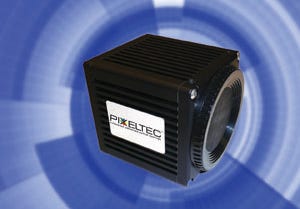Multispectral SWIR Camera Focuses on Biomedical Applications
January 9, 2013
|
A multispectral camera that performs SWIR analysis at 700 to 1700 nm can be used in such biomedical applications as endoscopy. |
Shortwave infrared (SWIR) cameras have already revolutionized night vision goggles. The technology dramatically increases visibility and clarity over standard options. While the last movie you saw showing night vision systems probably evokes images of a grey green haze surrounding soldiers or buildings, objects viewed using SWIR technology are perfectly discernable. That's why Ocean Thin Films (Golden, CO) thinks the technology is perfectly suitable for medical device applications.
In an effort to exploit shortwave infrared technology, the company has introduced PixelCam, a snapshot, multispectral camera that performs SWIR analysis at 700 to 1700 nm. "Multispectral imaging is interesting and useful because it produces an image using only a small section of the spectrum, usually in the 10- to 100-nm range," explains Steve Smith, product manager at Ocean Thin Films. "The technology includes the nonvisible--UV and infrared--regions instead of strictly the visible range of 400 to 177 nm that your eyes are sensitive to."
To create the camera, the company paired its PixelTec precision micropatterned optical coating technology with SWIR-area sensor cameras manufactured by Sensors Unlimited (Princeton, NJ). Based on SWIR technology, the camera simultaneously acquires four or more standard and custom spectral bands using a single camera, enabling users to extract spectral information that is not noticeable using panchromatic SWIR devices. "The PixelCam represents a combination of technologies that facilitates a series of advanced applications," Smith says.
A snapshot multispectral imager captures all of the spectral information simultaneously," Smith comments. "Compare that to current multispectral instruments that mostly work by capturing a single spectral image at a time and then utilizes processing to extract interesting or meaningful information from those images."
The PixelCam multispectral camera uses a custom filter array integrated into a solid-state indium gallium arsenide imager with a resolution of 640×512. These high-transmission dichroic filter arrays are aligned directly over corresponding pixels in the imaging array, enabling the camera to achieve optimal spectral and spatial resolution. The camera platform also provides simultaneous 12-bit Camera Link digital and RS170 analog outputs and an external trigger. The form factor, frame rates, operating temperature, and power requirements are unchanged by the passive spectral filters. Thus, they can be integrated into handheld and mobile devices.
The camera, according to Smith, can be used in such biomedical imaging applications as noninvasive surgery. "For example, the speed of snapshot multispectral imaging might be useful in endoscopy, where you could look to find spectral signatures to differentiate healthy tissues from problematic cells." Multispectral imaging equipment, he adds, could be used in hospitals within 12 to 18 months. "We believe there will be a large market in the medical device world for this technology."
About the Author(s)
You May Also Like


.png?width=300&auto=webp&quality=80&disable=upscale)
